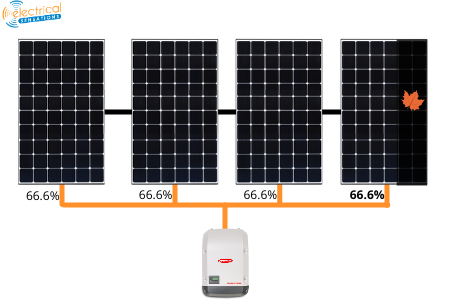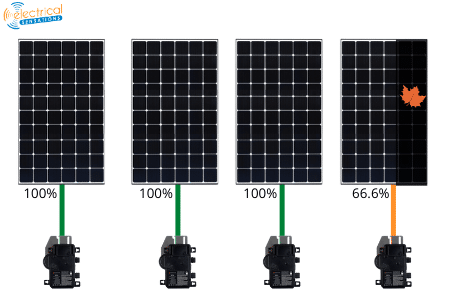String Inverters vs. Micro-Inverters: Which one is better?
- Electrical Sensations
- Mar 2, 2021
- 6 min read
Updated: Nov 23, 2023

Inverters are an essential component of any solar power system. The inverter's basic function is to invert Direct Current (DC) from the solar panels, into Alternating Current (AC) that can be used to operate your household appliances. The excess electricity that is not used in your home is then fed into the grid or stored in a solar battery (if you have batteries installed – this is a whole other topic that will be covered in a later article). With inverters being the main point of failure in most faulty systems, you must be getting a dependable, quality inverter. Two main types of inverters are used in residential solar, Micro-Inverters and regular, string inverters. Each with its benefits and downfalls.
Here’s how electricity flows through a standard solar panel
A standard solar panel has 60 cells. The electrical current passes through each of these cells before it exits the panel, as shown in the pictures below by the red path.
The blue lines at the bottom of the panel represent diodes. Most panels have three diodes. When one of the cells is shaded or has debris/leaves on it, the diodes provide an alternative path for the electricity to ‘bypass’ the shaded cell. This process, known as bypass diode, is shown in the last two pictures below. As a result, the solar panel’s voltage and power output will be reduced by one-third in this case. The purpose of this is to allow the affected panel to still produce electricity, rather than the entire panel producing nothing at all. This information becomes important when comparing string and micro-inverters, in terms of output and efficiency.
String Inverters

A string inverter (about the size of a briefcase) is installed on a wall and all the solar panels connect to it. For residential solar, typically only one string inverter is needed per system. If your panels have little to no shading and do not face multiple different directions, a string inverter system is a cost-effective, proven solution.
But what is a ‘string’? What does it mean?
A string is a group of solar panels that are connected in a series. The current flows through a path that goes through all of the panels. However, this means that if something is restricting the current in one panel, all of the panels in that string will also be restricted. Therefore, if one panel is shaded/dirty and is only operating at 66.6% (2/3 capacity), the output of all of the other panels will be reduced (as seen below). If shading is not an issue on your roof and your panels are positioned ideally for solar, output reduction is typically not a major concern. In this case, a string inverter is a reliable, durable and affordable solution.
Saying that string inverters are evolving and starting to incorporate new technology to reduce the effects of shading. For example, SMA Sunny Boy Inverters now include built in ‘ShadeFix’ technology. SMA ShadeFix is a software-based shade management system that increases the energy production of a solar power system under light to medium shading conditions. If you have a little bit of shade, this can be a very effective solution without having to pay for Micro-Inverters.
Micro-Inverters
For example, Enphase

MicroInverter (about the size of an A5 piece of paper) is installed on the back of, or beside each solar panel. This means that usually, the number of solar panels = the number of microinverters needed. Micro-inverters are usually used for more complex installations, where there may be partial shading, tilted panels at various angles and/or panels facing multiple directions.
What makes micro-inverters different from string inverters, is that because each solar panels is connected to its own Micro-Inverter, if one panel isn’t performing well, it does not affect the performance of other panels in the system. This means that the system will be more efficient and able to generate more electricity, in situations when part of the system may be shaded or something is obstructing the sun from the panels. Micro-inverters also allow you to individually monitor the panels. This can make troubleshooting, servicing and maintenance quick and easy. Micro-inverters also produce a much lower voltage than a system with a string inverter. This means that the risk of overheating and potentially starting a fire is greatly reduced.
However, Micro-Inverters have a premium price tag. The additional upfront cost of Micro-Inverters is justified for some installations for the added monitoring and production benefits.
What are the benefits?
String Inverters
COST: Based on a 6.6kW Solar System with 19 x 350kW Premium LG NeON2 panels, installing a SMA 5.0 Sunny Boy string inverter was approximately $2,800 LESS compared to installing 19 x Enphase Micro-Inverters (as seen in the graph below). These figures are just an estimate and will vary depending on the quality and size of your system.
HIGHER YEILD (IN LITTLE TO NO SHADE): When there is very little shading on your roof, string inverters are very efficient.
LOWER NUMBER OF ELECTRONIC COMPONENTS: As well as a lower system cost, having less electronic components means that inverter troubleshooting can be easier because there is only one point of failure.
Micro-Inverters
SUITABILITY FOR CHALLENGING INSTALLS: Micro-Inverters are a great solution for roofs that have shading or panels on multiple roof pitches and facing different directions.
LONGER LIFE SPAN: The average life span of a Micro-Inverter is up to 20 years (Solar Calculator, 2020).
ADDED MONITORING: As each panel has it’s own Micro-Inverter, this allows you to individually monitor the performance and yield of each panel.
HIGHER YEILD (WHEN THERE IS SHADING): Microinverters operate independently, so each panel performs to its fullest (Enphase, 2021). If one panel is shaded or dirty, it won’t affect the rest of the system.
What are the downfalls?
String Inverters
LESS EFFICIENT IN SHADE: Whether it’s a tree casting a shadow onto your roof or your panels are dirty, when some of the panels are shaded regularly, the entire system will be less efficient and will produce a lower yield. Realistically, this means that you will sell less back and your system will take longer to pay off.
SHORTER LIFE SPAN: The average life span of a string inverter is 8 to 12 years – that’s 8 to12 years less than Micro-Inverters (Solar Calculator, 2020).
Micro-Inverters
COST: Micro-inverters are more expensive than traditional string inverters – especially for larger systems. When installing micro-inverters, accessories (such as an AC Cable coupler) are also needed which adds to the cost of the system.
MORE POTENTIAL POINTS OF FAILURE: More electronics on you roof means that there are more points of potential failures.

Tips, Brand Recommendations and Advice
Installing a reliable, quality inverter is vital to ensure the longevity and performance of your solar system. It’s really important to realise that a long-lasting, reliable system is the product of BOTH the panels and the inverter. In my opinion, there’s no point in spending big on quality solar panels if you don’t have a dependable inverter to match. It’s like putting a lawnmower motor in a Lamborghini body… The type and brand of the inverter is not something that you want to gloss over.
If your installer is very vague about what specific inverter you will be getting or does not mention a brand at all = BIG RED FLAG. You are investing a lot of money, you need to know the size, brand and model of the inverter you are being sold.
If your roof is ideal, or close to ideal, for solar and no or little shade, it is debatable whether paying a premium price for Micro-Inverters is worth it. I would highly recommend discussing with your installer/designer about the inverter and getting them to explain why they have suggested that specific inverter for you – if they can’t justify why and back it up, that’s another red flag…
Recommended brands for string inverters: The best inverter manufacturers in terms of reliability, performance and longevity in my opinion are SMA and Fronius. The inverter that we install the most and prefer to use is the SMA Sunny Boy/Tripower. SMA is a trusted, European company. With German engineering and design and ShadeFix technology, SMA has been renowned for producing quality, reliable solar inverters for close to 40 years. Fronius is another premium brand of inverters that has a proven track record of reliability and an outstanding reputation within the solar industry. With a maximum efficiency of 98.1% (Fronius, 2021), Fronius inverters performance and reliability are undeniable.
Recommended brands for Micro-Inverters: Enphase is one of the leading Micro-Inverter manufacturers in Australia and is the brand that I choose to install when Micro-Inverters are the best solution. I prefer to use the Enphase IQ 7A Micro-Inverter to achieve the greatest yield from the solar system.
I have done up a quick side-by-side comparison of two inverters: The SMA Sunny Boy 5.0 (string inverter) and the Enphase Micro-Inverter IQ 7A. In terms of performance, reliability and manufacturer support, these are two of the inverters that I choose to install and have great confidence in.

Please also be aware that this article is solely comparing micro-inverters and regular string inverters. There are other methods, such as DC optimisers and smart panels, that also can be used to minimise the effects of shading and maximise output. It’s important to consider all your options to get a personalised, efficient and long-lasting Solar Power System.
If you have any questions about the different types of inverters, please don’t hesitate to reach out to our team. Our office number is 4637 2744 or you can find us at 57 Gipps Street, Drayton (Toowoomba) QLD.

















Comments